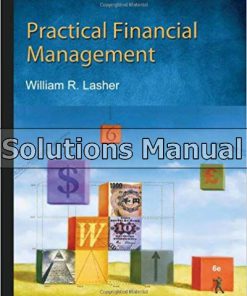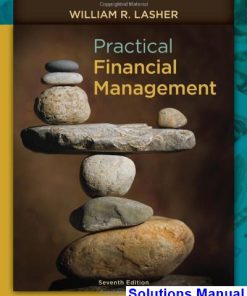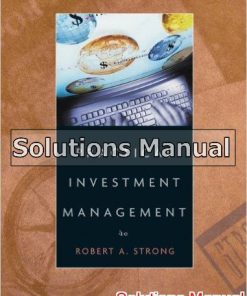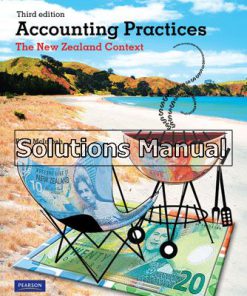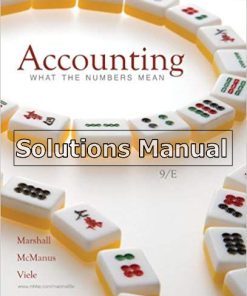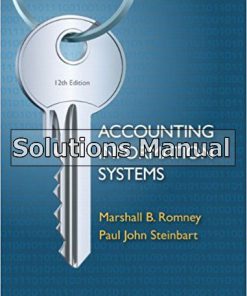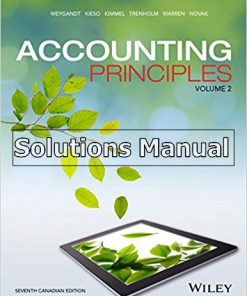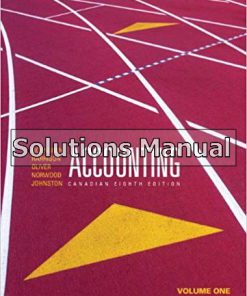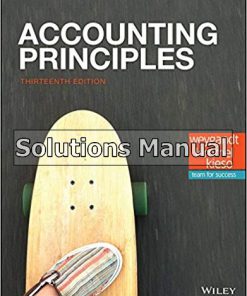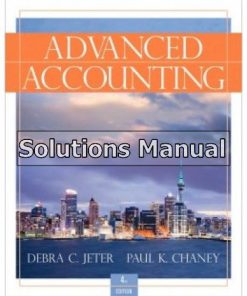Practical Management Science 5th Edition Winston Solutions Manual
$50.00 Original price was: $50.00.$26.50Current price is: $26.50.
Practical Management Science 5th Edition Winston Solutions Manual.
Practical Management Science 5th Edition Winston Solutions Manual

Product details:
- ISBN-10 : 1305631544
- ISBN-13 : 978-1305631540
- Author: Wayne L. Winston
Geared entirely to Excel 2013, PRACTICAL MANAGEMENT SCIENCE uses an active-learning approach and realistic problems to help you take full advantage of the power of spreadsheet modeling. The text presents just the right amount of theory to ensure you understand the foundation of the topic, followed by exercises that give you practical, hands-on experience with the methodologies. Drawing examples and problems from finance, marketing, operations management, and other areas, the text illustrates how management science applies to your chosen profession–and how you can use it on the job. The authors emphasize modeling over algebraic formulations and memorization of particular models. The text includes access to Palisade DecisionTools Suite (BigPicture, @RISK, PrecisionTree, StatTools, TopRank, NeuralTools, and Evolver) as well as SolverTable, which allows you to do sensitivity analysis on optimization models.
Table contents:
- Ch 1: Introduction to Modeling
- 1.1 Introduction
- 1.2 A Capital Budgeting Example
- 1.3 Modeling versus Models
- 1.4 A Seven-Step Modeling Process
- 1.5 A Great Source for Management Science Applications: Interfaces
- 1.6 Why Study Management Science?
- 1.7 Software Included with This Book
- 1.8 Conclusion
- Ch 2: Introduction to Spreadsheet Modeling
- 2.1 Introduction
- 2.2 Basic Spreadsheet Modeling: Concepts and Best Practices
- 2.3 Cost Projections
- 2.4 Breakeven Analysis
- 2.5 Ordering with Quantity Discounts and Demand Uncertainty
- 2.6 Estimating the Relationship between Price and Demand
- 2.7 Decisions Involving the Time Value of Money
- 2.8 Conclusion
- Appendix Tips for Editing and Documenting Spreadsheets
- Case 2.1: Project Selection at Ewing Natural Gas
- Case 2.2: New Product Introduction at eTech
- Ch 3: Introduction to Optimization Modeling
- 3.1 Introduction
- 3.2 Introduction to Optimization
- 3.3 A Two-Variable Product Mix Model
- 3.4 Sensitivity Analysis
- 3.5 Properties of Linear Models
- 3.6 Infeasibility and Unboundedness
- 3.7 A Larger Product Mix Model
- 3.8 A Multiperiod Production Model
- 3.9 A Comparison of Algebraic and Spreadsheet Models
- 3.10 A Decision Support System
- 3.11 Conclusion
- Appendix Information on Solvers
- Case 3.1: Shelby Shelving
- Case 3.2: Sonoma Valley Wines
- Ch 4: Linear Programming Models
- 4.1 Introduction
- 4.2 Advertising Models
- 4.3 Employee Scheduling Models
- 4.4 Aggregate Planning Models
- 4.5 Blending Models
- 4.6 Production Process Models
- 4.7 Financial Models
- 4.8 Data Envelopment Analysis (DEA)
- 4.9 Conclusion
- Case 4.1: Blending Aviation Gasoline at Jansen Gas
- Case 4.2: Delinquent Accounts at GE Capital
- Case 4.3: Foreign Currency Trading
- Ch 5: Network Models
- 5.1 Introduction
- 5.2 Transportation Models
- 5.3 Assignment Models
- 5.4 Other Logistics Models
- 5.5 Shortest Path Models
- 5.6 Network Models in the Airline Industry
- 5.7 Conclusion
- Case 5.1: International Textile Company, Ltd.
- Case 5.2: Optimized Motor Carrier Selection at Westvaco
- Ch 6: Optimization Models with Integer Variables
- 6.1 Introduction
- 6.2 Overview of Optimization with Integer Variables
- 6.3 Capital Budgeting Models
- 6.4 Fixed-Cost Models
- 6.5 Set-Covering and Location-Assignment Models
- 6.6 Cutting Stock Models
- 6.7 Conclusion
- Case 6.1: Giant Motor Company
- Case 6.2: Selecting Telecommunication Carriers to Obtain Volume Discounts
- Case 6.3: Project Selection at Ewing Natural Gas
- Ch 7: Nonlinear Optimization Models
- 7.1 Introduction
- 7.2 Basic Ideas of Nonlinear Optimization
- 7.3 Pricing Models
- 7.4 Advertising Response and Selection Models
- 7.5 Facility Location Models
- 7.6 Models for Rating Sports Teams
- 7.7 Portfolio Optimization Models
- 7.8 Estimating the Beta of a Stock
- 7.9 Conclusion
- Case 7.1: GMS Stock Hedging
- Ch 8: Evolutionary Solver: An Alternative Optimization Procedure
- 8.1 Introduction
- 8.2 Introduction to Genetic Algorithms
- 8.3 Introduction to Evolutionary Solver
- 8.4 Nonlinear Pricing Models
- 8.5 Combinatorial Models
- 8.6 Fitting an S-Shaped Curve
- 8.7 Portfolio Optimization
- 8.8 Cluster Analysis
- 8.9 Discriminant Analysis
- 8.10 The Traveling Salesperson Problem
- 8.11 Conclusion
- Case 8.1: Assigning MBA Students to Teams
- Case 8.2: Project Selection at Ewing Natural Gas
- Ch 9: Decision Making under Uncertainty
- 9.1 Introduction
- 9.2 Elements of Decision Analysis
- 9.3 One-Stage Decision Problems
- 9.4 The Precisiontree Add-In
- 9.5 Multistage Decision Problems
- 9.6 The Role of Risk Aversion
- 9.7 Conclusion
- Case 9.1: Jogger Shoe Company
- Case 9.2: Westhouser Paper Company
- Case 9.3: Electronic Timing System for Olympics
- Case 9.4: Developing a Helicopter Component for the Army
- Ch 10: Introduction to Simulation Modeling
- 10.1 Introduction
- 10.2 Probability Distributions for Input Variables
- 10.3 Simulation and the Flaw of Averages
- 10.4 Simulation with Built-In Excel Tools
- 10.5 Introduction to @Risk
- 10.6 The Effects of Input Distributions on Results
- 10.7 Conclusion
- Appendix Learning More about @Risk
- Case 10.1: Ski Jacket Production
- Case 10.2: Ebony Bath Soap
- Case 10.3: Advertising Effectiveness
- Case 10.4: New Product Introduction at eTech
- Ch 11: Simulation Models
- 11.1 Introduction
- 11.2 Operations Models
- 11.3 Financial Models
- 11.4 Marketing Models
- 11.5 Simulating Games of Chance
- 11.6 Conclusion
- Appendix Other Palisade Tools for Simulation
- Case 11.1: College Fund Investment
- Case 11.2: Bond Investment Strategy
- Case 11.3: Project Selection at Ewing Natural Gas
- Ch 12: Inventory and Supply Chain Models
- 12.1 Introduction
- 12.2 Categories of Inventory and Supply Chain Models
- 12.3 Types of Costs in Inventory and Supply Chain Models
- 12.4 Economic Order Quantity (EOQ) Models
- 12.5 Probabilistic Inventory Models
- 12.6 Ordering Simulation Models
- 12.7 Supply Chain Models
- 12.8 Conclusion
- Case 12.1: Subway Token Hoarding
- Ch 13: Queueing Models
- 13.1 Introduction
- 13.2 Elements of Queueing Models
- 13.3 The Exponential Distribution
- 13.4 Important Queueing Relationships
- 13.5 Analytic Steady-State Queueing Models
- 13.6 Queueing Simulation Models
- 13.7 Conclusion
- Case 13.1: Catalog Company Phone Orders
- Case 13.2: Pacific National Bank
- Ch 14: Regression and Forecasting Models
- 14.1 Introduction
- 14.2 Overview of Regression Models
- 14.3 Simple Regression Models
- 14.4 Multiple Regression Models
- 14.5 Overview of Time Series Models
- 14.6 Moving Averages Models
- 14.7 Exponential Smoothing Models
- 14.8 Conclusion
- Case 14.1: Demand for French Bread at Howie’s Bakery
- Case 14.2: Forecasting Overhead at Wagner Printers
- Case 14.3: Arrivals at the Credit Union
- References
- Index
People also search:
practical management science 5th edition
practical management science 5th edition pdf
what is practical management
practical solutions on how any five
practical management science 4th edition solutions pdf
Instant download after Payment is complete
You may also like…
Solutions Manual
Practical Management Science 6th Edition Winston Solutions Manual
Solutions Manual
Practical Financial Management 6th Edition Lasher Solutions Manual
Solutions Manual
Solutions Manual
Practical Management Science 4th Edition Winston Solutions Manual
Solutions Manual
Solutions Manual
Solutions Manual
Practical Investment Management 4th Edition Strong Solutions Manual
Related products
Solutions Manual
Solutions Manual
Accounting Information Systems 12th Edition Romney Solutions Manual
Solutions Manual
Accounting Volume 1 Canadian 8th Edition Horngren Solutions Manual
Solutions Manual
Accounting Principles 13th Edition Weygandt Solutions Manual
Solutions Manual





